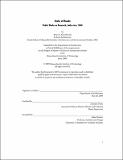| dc.contributor.advisor | Arindam Dutta. | en_US |
| dc.contributor.author | Khorakiwala, Ateya A | en_US |
| dc.contributor.other | Massachusetts Institute of Technology. Dept. of Architecture. | en_US |
| dc.coverage.spatial | a-ii--- | en_US |
| dc.date.accessioned | 2009-11-06T14:49:32Z | |
| dc.date.available | 2009-11-06T14:49:32Z | |
| dc.date.copyright | 2009 | en_US |
| dc.date.issued | 2009 | en_US |
| dc.identifier.uri | http://hdl.handle.net/1721.1/49540 | |
| dc.description | Thesis (S.M.)--Massachusetts Institute of Technology, Dept. of Architecture, 2009. | en_US |
| dc.description | This electronic version was submitted by the student author. The certified thesis is available in the Institute Archives and Special Collections. | en_US |
| dc.description | Includes bibliographical references (p. 114-116). | en_US |
| dc.description.abstract | That the road is a symbol of the prowess of the nation-state seems tautological, a uni"ed phenomenon of political symbolism that manifests as an infrastructural network. When subjected to a close historical examination, the texture of this tautology begins to disintegrate; the road emerges as a nuanced geographical object created by the state. On one hand, the newly independent India of 1947 attempted to presence itself within its jurisdiction through the road, laying administrative claim to any territory that it could pave. On the other, the state, through the road, had to contend with the topography of its land, its ancient and tenuous geological formations, the stretching and creeping of its mountains, and other vagaries of nature. This had to be done within the framework of a nation violently birthed from two hundred years of colonial rule, its limited economic resources, cement shortages, lack of technical expertise, and contingencies of available infrastructural networks. The state's attempt at being modern, doing modernity, emerged in the details of road making. In the 1960s research projects investigating rigid and flexible pavements were funded, street-paint and signage was experimented with, traffic studies and parking geometry was produced, and new mixes of concrete were developed; the state's modernity manifested as a central research institute whose task it was to rationalize existing knowledge, and produce new knowledge about roads and road building. The studies, reports, and handbooks produced by their research institutes represent the state's desired discourse of rational modernity. | en_US |
| dc.description.abstract | (cont.) Yet, in reading this material against the grain, reading it textually, a counter discourse of the difficulty of deploying modernity in a country like India. I argue that the road can be read as an archive, a repository of 1960s India's governmental desire. | en_US |
| dc.description.statementofresponsibility | by Ateya A. Khorakiwala. | en_US |
| dc.format.extent | 116 p. | en_US |
| dc.language.iso | eng | en_US |
| dc.publisher | Massachusetts Institute of Technology | en_US |
| dc.rights | M.I.T. theses are protected by
copyright. They may be viewed from this source for any purpose, but
reproduction or distribution in any format is prohibited without written
permission. See provided URL for inquiries about permission. | en_US |
| dc.rights.uri | http://dspace.mit.edu/handle/1721.1/7582 | en_US |
| dc.subject | Architecture. | en_US |
| dc.title | State of roads : public works as research, India circa 1960 | en_US |
| dc.title.alternative | state of roads post independence public works | en_US |
| dc.type | Thesis | en_US |
| dc.description.degree | S.M. | en_US |
| dc.contributor.department | Massachusetts Institute of Technology. Department of Architecture | |
| dc.identifier.oclc | 437430656 | en_US |
